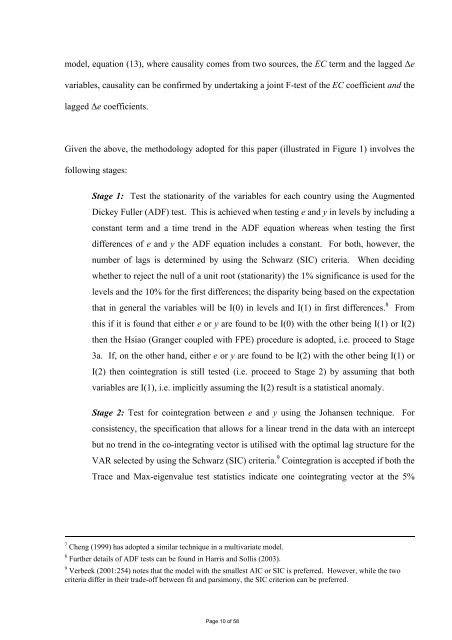Causality between Energy Consumption and GDP: Evidence from ...
Causality between Energy Consumption and GDP: Evidence from ...
Causality between Energy Consumption and GDP: Evidence from ...
Create successful ePaper yourself
Turn your PDF publications into a flip-book with our unique Google optimized e-Paper software.
model, equation (13), where causality comes <strong>from</strong> two sources, the EC term <strong>and</strong> the lagged ∆evariables, causality can be confirmed by undertaking a joint F-test of the EC coefficient <strong>and</strong> thelagged ∆e coefficients.Given the above, the methodology adopted for this paper (illustrated in Figure 1) involves thefollowing stages:Stage 1: Test the stationarity of the variables for each country using the AugmentedDickey Fuller (ADF) test. This is achieved when testing e <strong>and</strong> y in levels by including aconstant term <strong>and</strong> a time trend in the ADF equation whereas when testing the firstdifferences of e <strong>and</strong> y the ADF equation includes a constant. For both, however, thenumber of lags is determined by using the Schwarz (SIC) criteria. When decidingwhether to reject the null of a unit root (stationarity) the 1% significance is used for thelevels <strong>and</strong> the 10% for the first differences; the disparity being based on the expectationthat in general the variables will be I(0) in levels <strong>and</strong> I(1) in first differences. 8 Fromthis if it is found that either e or y are found to be I(0) with the other being I(1) or I(2)then the Hsiao (Granger coupled with FPE) procedure is adopted, i.e. proceed to Stage3a. If, on the other h<strong>and</strong>, either e or y are found to be I(2) with the other being I(1) orI(2) then cointegration is still tested (i.e. proceed to Stage 2) by assuming that bothvariables are I(1), i.e. implicitly assuming the I(2) result is a statistical anomaly.Stage 2: Test for cointegration <strong>between</strong> e <strong>and</strong> y using the Johansen technique. Forconsistency, the specification that allows for a linear trend in the data with an interceptbut no trend in the co-integrating vector is utilised with the optimal lag structure for theVAR selected by using the Schwarz (SIC) criteria. 9 Cointegration is accepted if both theTrace <strong>and</strong> Max-eigenvalue test statistics indicate one cointegrating vector at the 5%7 Cheng (1999) has adopted a similar technique in a multivariate model.8 Further details of ADF tests can be found in Harris <strong>and</strong> Sollis (2003).9 Verbeek (2001:254) notes that the model with the smallest AIC or SIC is preferred. However, while the twocriteria differ in their trade-off <strong>between</strong> fit <strong>and</strong> parsimony, the SIC criterion can be preferred.Page 10 of 58


